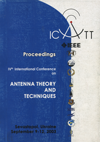The videopulse scattering in inhomogeneous media containing conductive cylinder objects
DOI:
https://doi.org/10.1109/ICATT.2003.1239172Keywords:
videopulse, GPR, computer simulation, FDTD-method, profileAbstract
The results of the computer simulation of videopulse scattering on the conductive cylinder objects buried in homogeneous media are presented in this work. The finite difference time domain method (FDTD) and Mur's absorbing boundary conditions of second order were used to regularize the problem. The analysis and the comparison of the scattered electromagnetic fields obtained at different dielectric parameters of the media and different sizes of the conductive objects were carried out.References
Taflove. Computational electrodynamics. The Finite-Difference Time-Domain Method. Boston-London: Artech House, 1995.
Peterson, F.; Ray, S.L.; Mittra, R. Computational Methods for Electromagnetics. New York: IEEE PRESS. Oxford, Tokyo, Melbourne: Oxford University Press, 1997.
Varyanitza-Roshchupkina, L.A.; Kovalenko, V.O. Pulse scattering on objects in the inhomogeneous conducting medium. Radio Physics and Radio Astronomy, 2002, Vol. 7, No. 4, pp. 435-440.
Yee, K.S. Numerical solution of initial boundary value problems involving Maxwell’s equations in isotropic media. IEEE Trans. Antennas Propag., Vol. AP-14, May 1966.
Mur, G. Absorbing boundary conditions for the finite-difference approximation of the time- domain electromagnetic field equations. IEEE Trans. Electromagnetic Compatibility, Vol. EMC-23, Nov. 1981.
Vladov, M.L.; Starovoytov, A.V. Geo radar overburden investigations. Moscow University House, 1999 (in Russian).
Golovko, M.M.; Pochanin, G.P. Kovalenko, V.O. Presentation of the subsurface videopulse sounding. Radiophysics and Electronics, Vol. 5, No. 2, 2000, pp. 134-143 (in Russian).
Finkelshtein, M.I.; Mendelson, V.L.; Kutev, V.A. Layered ground surface radiolocation. Moscow: Soviet Radio, 1977 (in Russian, ed. by M. I. Finkelshtein).

